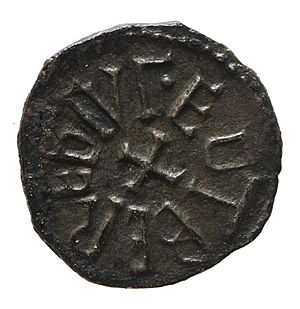Eadberht of Northumbria facts for kids
Quick facts for kids Eadberht |
|
|---|---|

A sceat of Eadberht
|
|
| King of Northumbria | |
| Reign | 737–758 |
| Predecessor | Ceolwulf |
| Successor | Oswulf |
| Died | 19 or 20 August 768 York, England |
| Burial | York Minster |
| Issue | Oswulf, King of Northubria Oswine Osgifu |
| House | Idings |
| Father | Eata |
| Religion | Christianity |
Eadberht (died 19 or 20 August 768) was a powerful king of Northumbria. He ruled from 737 or 738 until 758. Eadberht was the brother of Ecgbert, Archbishop of York, a very important church leader.
His time as king brought back some of the glory and power Northumbria had in the 600s. It was also a time when the kingdom became richer. Eadberht faced challenges from other powerful families. Some people who could have been rivals were removed from power during his reign. In 758, he decided to give up his crown. He became a monk at York, and his son Oswulf became the new king.
Contents
Becoming King of Northumbria
Eadberht became king after his cousin, Ceolwulf, stepped down for the second time. Ceolwulf chose to become a monk at the Lindisfarne monastery. While Ceolwulf's first time leaving the throne was forced, his second time, when Eadberht became king, might have been his own choice.
Eadberht was the son of a man named Eata. His family was part of the Idings, a royal line that came from Ida of Bernicia. Ida was an early king in the region.
Challenges and Changes in Northumbria
King Eadberht faced challenges from other strong families throughout his rule. These families wanted power too. For example, Eardwine, who was likely the grandson of a former king, was killed in 740.
In 750, another important person named Offa was taken from a safe church place in Lindisfarne. He was put to death after a fight. Bishop Cynewulf of Lindisfarne, who probably supported Offa, was removed from his position. He was held in York. This shows how much religious places were involved in the political fights of Northumbria.
Eadberht, however, had a strong ally. His brother was the Archbishop of York. This meant he had the support of the most important church leader in Northumbria.
New Coins and Land Disputes
During Eadberht's reign, there were big changes to Northumbria's money. New coins were made. Some of these coins even showed the names of both King Eadberht and Archbishop Ecgberht. This suggests that Eadberht was bringing new wealth to his kingdom.
A letter from Pope Paul I to Eadberht and Ecgberht also gives us clues. The Pope asked them to return lands that had been taken from a church leader. These lands had been given to Eadberht's brother, Moll. This suggests that Eadberht might have been trying to get back some of the large amounts of land that had been given to the church in earlier times.
Northumbria's Neighbors and Wars
Historians believe that King Eadberht wanted Northumbria to be as powerful as it was in the 600s. He wanted his kingdom to control more land and have more influence.
His efforts to expand Northumbria's power began around 740. At that time, there was a war between the Picts and the Northumbrians. While Eadberht was busy fighting, Æthelbald, the King of Mercia, attacked Northumbrian lands. The reason for this war is not fully clear. Some think it was connected to the death of Eardwine. Eardwine's father had been living in the north after a civil war. It's possible that the Pictish king or Æthelbald tried to put Eardwine on the Northumbrian throne.
Conquests and Campaigns
In 750, Eadberht successfully took control of a flat area called Kyle. Then, in 756, he joined forces with King Óengus of the Picts. They campaigned together against the Britons who lived in Alt Clut.
A historical record describes this campaign:
- In the year 756, King Eadberht, in his eighteenth year of ruling, and Óengus, king of Picts, led their armies to the town of Dumbarton.
- The Britons agreed to terms there on August 1st.
- However, on August 10th, almost the entire army that Eadberht led from Ouania to Niwanbirig was lost.
Ouania is now believed to be Govan. The exact location of Newanbirig is less certain. It might be Newburgh-on-Tyne near Hexham. Another idea is that Newanbirig was Newborough in the kingdom of Mercia. If Eadberht and Óengus were defeated by Æthelbald's Mercians there, it would fit with an old story. This story says that King Óengus founded a church to thank Saint Andrew for saving him after a defeat in Mercia.
Eadberht's Abdication and Legacy
King Eadberht gave up his throne in 758. He then entered the monastery connected to the cathedral in York. He died there on August 19 or 20, 768.
Historical records say that Eadberht was buried in the porch of the cathedral. His brother, Ecgberht, who had died in 766, was buried there too.
His son, Oswulf, became king after him. But Oswulf was killed within a year. However, Eadberht's family continued to be important. His daughter Osgifu's husband, Alhred, later became king. Eadberht's descendants, like Oswulf's son Ælfwald and Osgifu's son Osred, fought for the Northumbrian throne for many years. The last known descendant of Eadberht was Osgifu's son, Saint Alhmund. He was killed in 800 and is remembered as a martyr.


